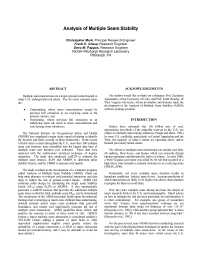Mining Publication: Analysis of Multiple Seam Stability
Original creation date: January 2007
Multiple seam interactions are a major ground control hazard in many U.S. underground coal mines. The two most common types are: Undermining, where stress concentrations caused by previous full extraction in an overlying seam is the primary concern, and; Overmining, where previous full extraction in an underlying seam can result in stress concentrations and rock damage from subsidence. The National Institute for Occupational Safety and Health (NIOSH) has completed a major study aimed at helping to identify the location and likely severity of these interactions. In the course of field visits to mines throughout the U.S., more than 300 multiple seam case histories were assembled into the largest data base of multiple seam case histories ever collected. These data were analyzed with the multivariate statistical technique of logistic regression. The study also employed LaM2D to estimate the multiple seam stresses, ALPS and ARMPS to determine pillar stability factors, and the CMRR to measure roof quality. The study resulted in the development of a computer program, called Analysis of Multiple Seam Stability (AMSS), which can help mine planners to evaluate each potential interaction and take steps to reduce the risk of ground control failure. AMSS first evaluates pillar design by calculating the single seam Stability Factor (SFSS) using ALPS or ARMPS. It also automatically generates a LaM2D analysis that provides the additional multiple seam stress so that the final, multiple seam SFMS can be determined. The second part of the AMSS procedure builds upon the statistical findings that overmining is much more difficult than undermining, isolated remnant pillars cause more problems than gob-solid boundaries, and weaker roof significantly increases the risk of multiple seam interactions. AMSS quantifies these effects and predicts the outcome in terms of three levels of risk: GREEN (where a major multiple seam interaction is considered unlikely), YELLOW (where adding a pattern of cable bolts or other equivalent supplemental support could greatly reduce the probability of a major interaction.), or RED (a major interaction should be considered likely, and it may be desirable to avoid the area entirely).
Authors: C Mark, FE Chase, DM Pappas
Conference Paper - January 2007
NIOSHTIC2 Number: 20032441
In: Peng SS, Mark C, Finfinger GL, Tadolini SC, Khair AW, Heasley KA, Luo Y, eds. Proceedings of the 26th International Conference on Ground Control in Mining, July 31 - August 2, 2007, Morgantown, West Virginia, Morgantown, WV: West Virginia University, 2007; :5-18
See Also
- AMSS - Analysis of Multiple Seam Stability - 2.1.02
- ARMPS-HWM - Analysis of Retreat Mining Pillar Stability - Highwall Mining - 1.3.02
- Failure Mechanics of Multiple Seam Mining Interactions
- Ground Control Design for Highwall Mining
- Multiple Seam Longwall Mining in the U.S. - Lessons for Ground Control
- Multiple-Seam Mining in the United States: Design Based on Case Histories
- Pillar Strength and Design Methodology for Stone Mines
- Simplified Pre- and Post-Processing Technique for Performing Finite-Element Analyses of Deep Underground Mines
- Technology News 464 - Analysis of Retreat Mining Pillar Stability (ARMPS): Version 4.0 for Windows
- Using the Coal Mine Roof Rating (CMRR) to Assess Roof Stability in U.S. Coal Mines
- Page last reviewed: 9/20/2012
- Page last updated: 9/20/2012
- Content source: National Institute for Occupational Safety and Health, Mining Program


 ShareCompartir
ShareCompartir
